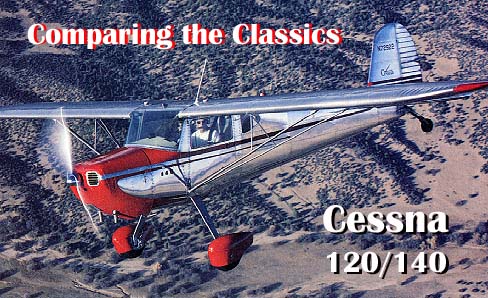

In 1946, when factories were cranking-out little airplanes like elves making cookies, Cessna didn't want to be left behind. They had done their own marketing studies and they too were convinced a world awash in ex-military pilots and GI's waving their GI bill checks would want airplanes. Lots of airplanes. They couldn't know how wrong they were.
Cessna, however, didn't have a design ready to go, where most other manufactures had been cranking out two-place training/recreational aircraft before the war. Cessna had to start from scratch. Although it isn't known how much, or if, they studied the Luscombe, there are too many configuration similarities to think otherwise. It would have to be assumed, they at least took note of that pre-war airplane's size, construction and success and took off from there.
120/140 Model Differences.
Let's start the conversation about Cessna 120/140's off right
by passing along the phone and address of the Cessna 120/140 club.
They are the people with all the answers.
Cessna 120/140 Club
Dave Lowe-President
Box 830082
Richardson, TX 75083
(502) 736-5392
The littlest Cessnas are not easy to tell apart and, for most of us, it was a proud day when we finally understood the subtle differences between the three basic models of two-place classic Cessnas, the 120, 140 and 140A.
First of all, the 120 and 140 were initially produced concurrently. It's unclear, however, whether the 120 was to be an economy model of the 140 or the 140 was to be the luxury version of the 120. However significant the marketing department thought the differences to be in 1946, the gap has narrowed to zero, since most consider the airplanes to be nearly interchangeable. The 140A, however, signaled a relatively major design improvement.

The 120 and 140
All Cessna 120s and 140s originally had fabric wings, two
steel struts and completely aluminum structure. A few have had
the fabric replaced with metal in the half century since their
birth. In fact, a few of the airplanes were even converted to
tricycle gear. Don't ask why, we don't understand either. Both
airplanes had the 85 hp Continental, although the 140 had an electrical
system as standard equipment. These days it's seldom a 120 is
seen without an electrical system. However, it's a fact that a
straight, clean 120 sans electrical will out fly the rest. In
little airplanes, weight is everything.
The visual differences between the two models include items which only the 140 has: the rear quarter windows and long, skinny flaps. We'll discuss the flaps later, but they shouldn't be the deciding factor between buying one model or the other. Then, as if things aren't confusing enough, a lot of 120s have magically sprouted the quarter windows of the 140.
140's received an up-dated instrument panel in 1948 which eliminated the "old-fashion" looking central cluster of instruments. A new floating panel spread the instruments across the cockpit. Radios are usually mounted left of the pilot's control yoke.
Cessna 140A
The "A" model was introduced in 1949, presumably
in an attempt to jump-start flagging sales. An estimated 525 were
built, including a small number of "Patroller" versions
with Plexiglas doors, 42 gallon tanks (!) and a message tube though
the floor. The fuselage remained the same, but the wings were
completely redesigned for the 140A. The blunt, rounded planform
disappeared to be replaced by an even more "modern"
appearing semi-tapered shape. When Fowler flaps were later added,
these were the wings which would be used on the still-to-come
150s. The C-85 was replaced with a C-90 in the 140A.
140A wings are stressed-skin aluminum, which eliminates the need for the second strut. This is why "A" models have a single, aluminum strut. The ailerons run the entire length of the tapered section and the tips are squared off. The flaps were shortened, but are several inches wider than straight 140 flaps and seem to be a little more effective.
"A" model landing gear legs are swept forward to
place the wheels further ahead of the CG than on the earlier airplanes.
This was done to protect the airplane from pilots transitioning
out of other two-place airplanes who had never flown with toe-brakes.
This is why it's common to see 120/140's with steel extensions
bolted to the gear legs which move the wheels ahead about four
inches. Many consider this to be overkill, as the brakes have
to be hit fairly hard to make the tail come up. It's a training
problem more than a hardware design flaw.
GO TO NEXT PAGE FOR FLYING CHARACTERISTICS